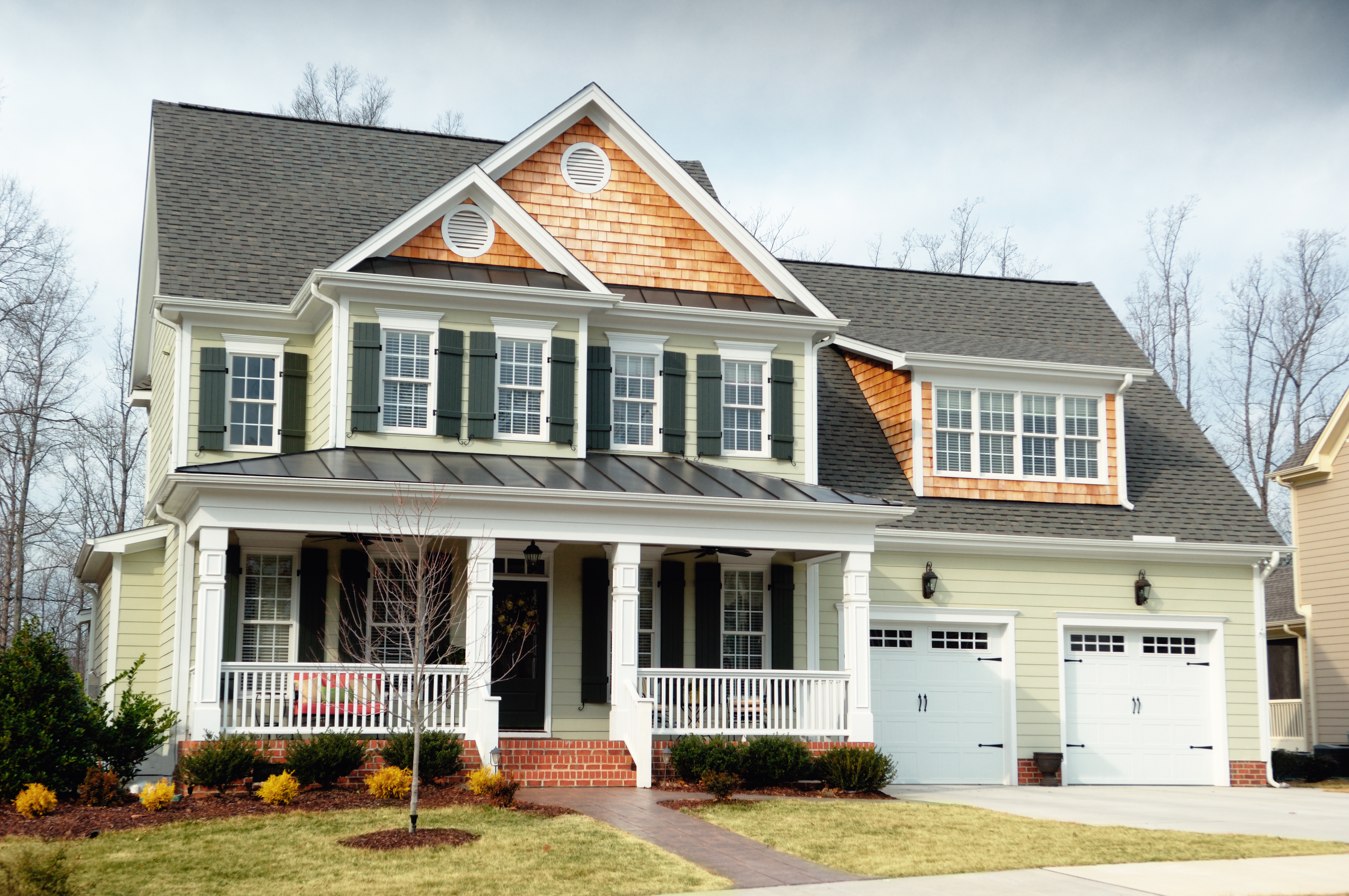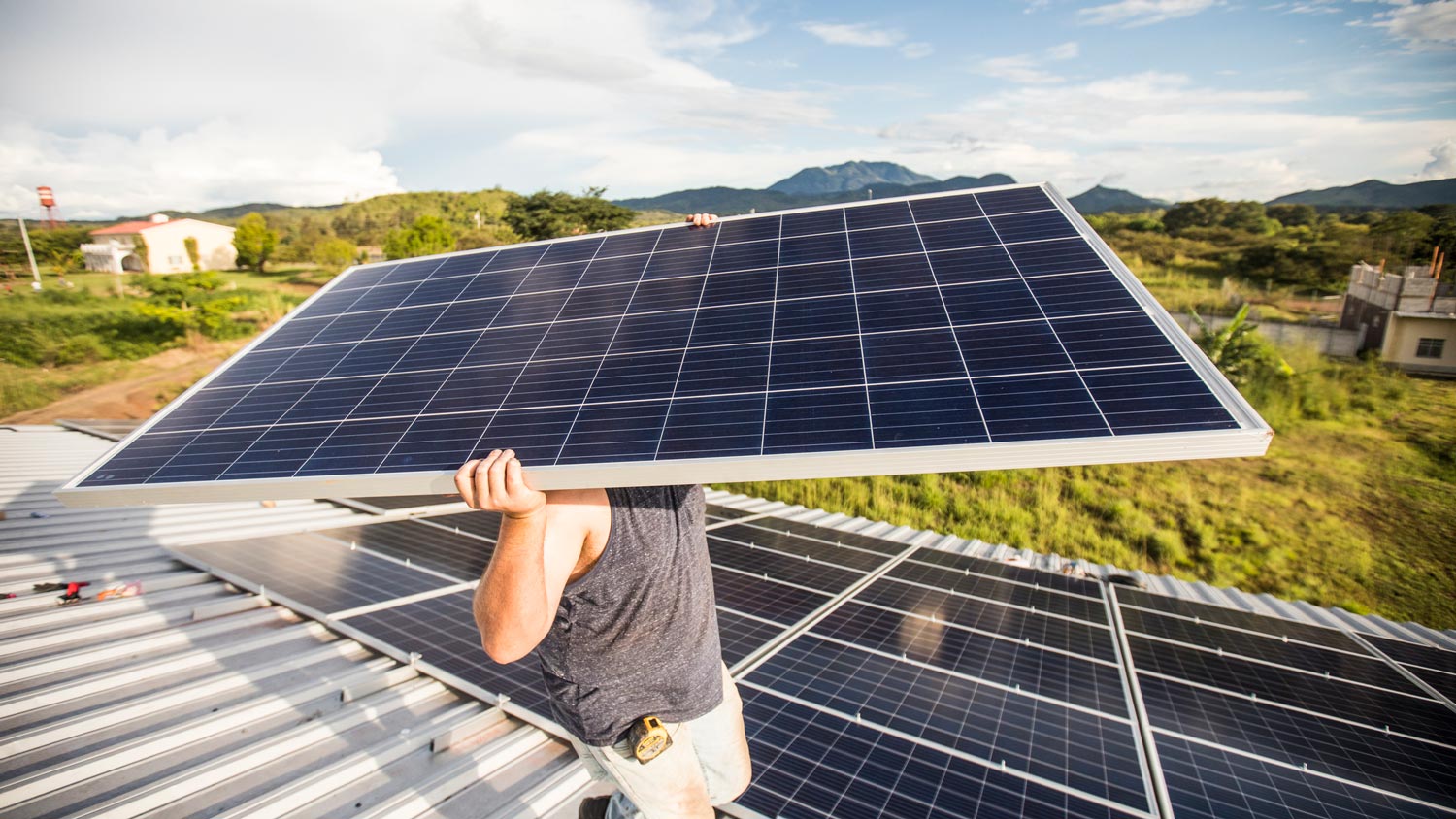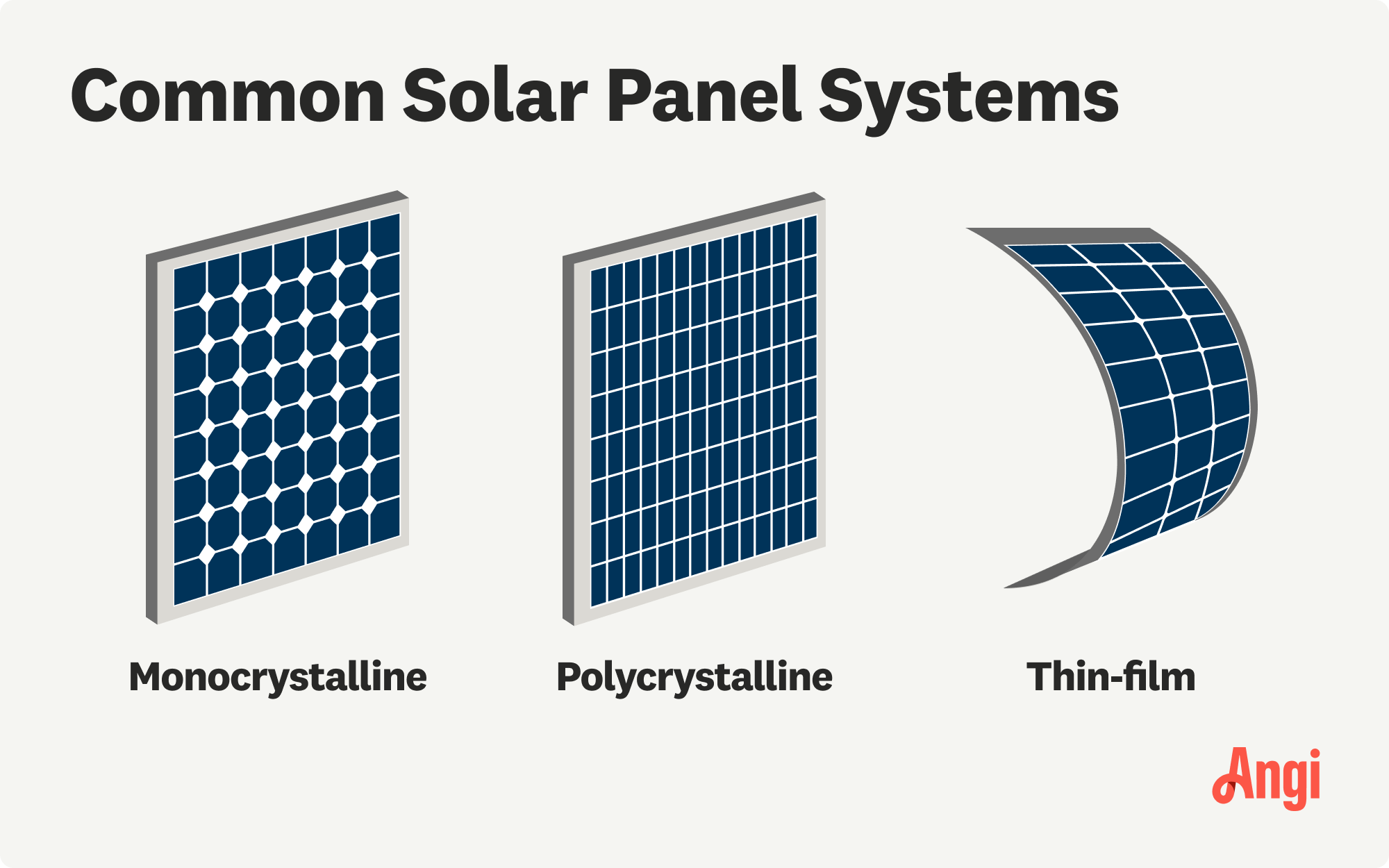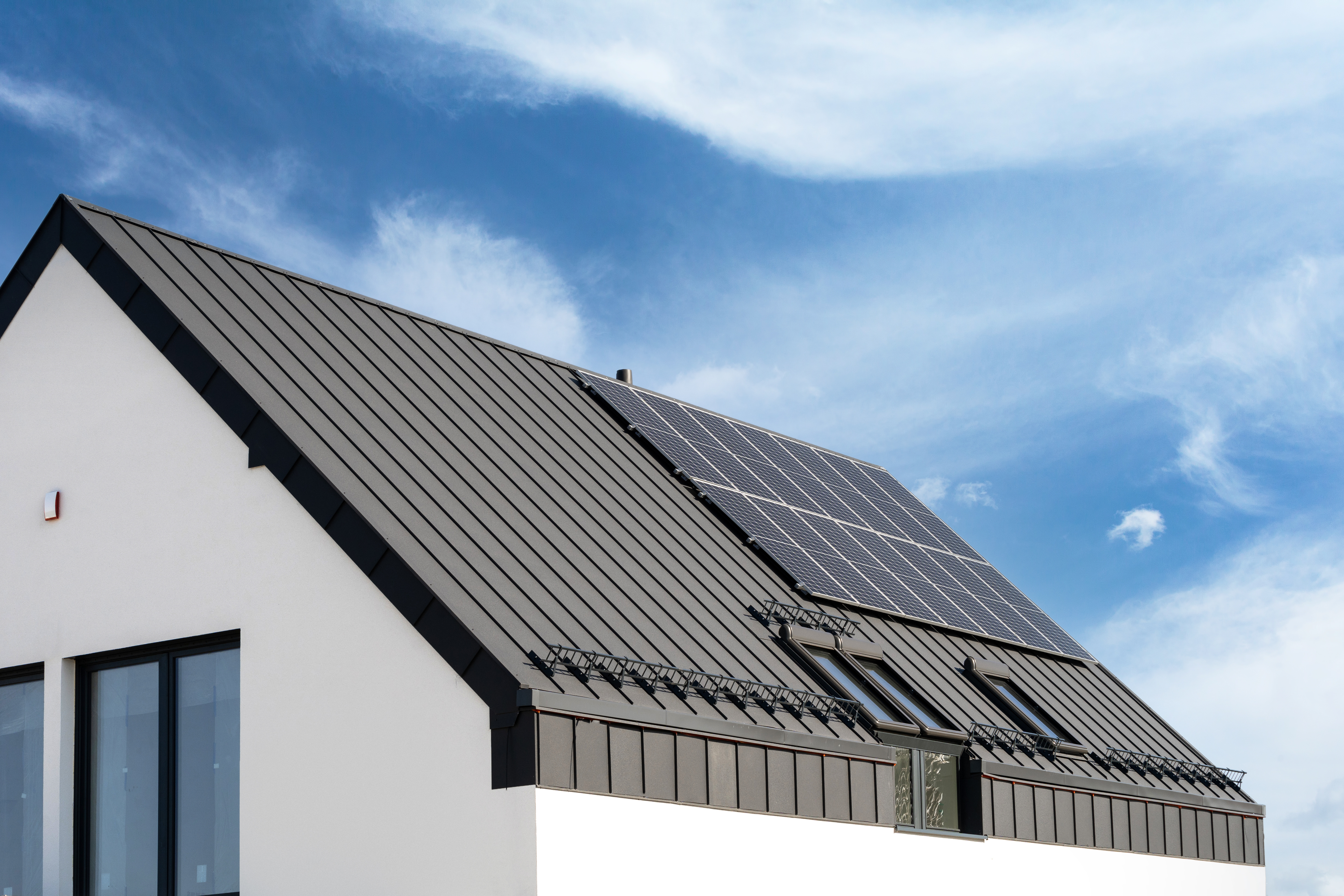
Dealing with a visibly damaged roof or leak? Learn about roof repair costs in Columbus to see how much you’ll need to budget for a permanent solution.
Metal roofs and solar panels go together like peanut butter and jelly


Metal roofs and solar panels have long life spans.
Both these roof and solar materials are recyclable.
Solar panels boost the cooling benefits of metal roofs.
LEED and Energy Star® certifications can improve home value.
Tax credits are available for solar panels.
Homeowners are going solar for savings and sustainability. If you want to go the extra mile to have an efficient home, nothing tops the combination of a metal roof with solar panels. Metal roofs are one of the best roof types for solar panels, so let’s look at how solar panels and metal roofs power up a home's value.
The obvious benefit of pairing metal and solar is that you will keep your home running using less energy. The secondary benefit is that both metal roofing and solar panels are recyclable. Compare that to the 20 billion pounds of asphalt roofing being dumped into landfills every year.
Both metal roofs and solar panels are in it for the long haul. While most shingle roofs last between 12 and 25 years, a metal roof will last between 40 and 70 years.
Next, solar panels can last up to 30 years when installed properly by a local solar panel pro. The beauty of combining metal with solar panels is that you do not have to worry about your panels outliving your roof the way you do with shingle roofs.
Installing solar panels on metal roofs is easier than on shingle roofs. However, because holes must be drilled when mounting panels, the situation can be precarious for some homes with shingle roofs.
An improperly mounted panel on a shingle roof can cause holes, leaks, mold, condensation, and other roof issues. The problem is eliminated with a metal roof because the mounting process is different with metal. There is usually no need to drill with standing-seam metal roofs and metal tile roofs. However, corrugated metal roofs do sometimes require drilling.
Did you know that solar panels can enhance the cooling benefits of your metal roof? If you are sold on metal roofing, you likely know that metal offers cooling benefits that allow homeowners to reduce energy usage.
The reflective qualities of metal roofs bounce back more sunlight than an alternative option like an asphalt shingle roof. In fact, the reflectivity of solar panels can help homeowners save up to 40% on energy bills. Solar panels amplify the cost savings by providing additional shade over the roof.

There are four main types of solar metal roofs to choose from: Standing seam, corrugated, exposed fastener, and metal shingles. Depending on where you live and the aesthetic you want, some metal roofs are a better choice for installing solar panels than others.
Standing seam metal roofs have hidden fasteners, and the seams interlock, creating a durable and aesthetically pleasing roof. This weather-resistant roofing material makes an excellent base for installing solar panels. The vertical ribs offer a place for solar mounting systems to attach and do not require penetrations to secure them. This means there are fewer areas that could admit water and create leaks and water damage down the road.
Exposed fastener metal roofs are installed as overlapping panels with exposed screws that attach to the roof deck. This metal roofing system is less expensive than a standing seam roof and is a popular choice for homeowners who want an economical roof with the benefits of metal. Installing solar panels on an exposed fastener metal roof requires screws to penetrate the roofing to attach the solar mounting hardware to the roof.
Corrugated metal roofs have a simple, industrial look and are more popular on sheds and barns than homes. But if you have a corrugated metal roof on your home or an outbuilding, it can work well for installing solar panels. Solar panel mounts can be installed on the corrugated roof, but this requires penetrating the roof with screws, so ensuring correct waterproofing is essential for protecting the roof and the interior of the building.
Metal shingles can mimic the look of other materials like clay tiles, cedar shakes, and slate tiles. Solar panels can be installed on this type of roofing, but like exposed fasteners and corrugated metal roofs, the solar mounting hardware must be fixed to the metal with screws that penetrate the material and fasten to the underlying sheathing and rafter. It can be challenging to find the right mounting solution, as metal shingles often have patterns stamped onto them and solar panels may require smooth, flat surfaces.
The three main types of solar panels are all well suited to metal roofs. Your choice will depend on your budget and the space available for solar panel installation.

Monocrystalline solar panels are a newer iteration of solar panel technology and are, therefore, more expensive than polycrystalline or thin-film. They offer efficiency rates between 15% and 20%, the highest among the three types of solar panels. Mono panels are black and well suited to high temperatures, so these panels may be the best choice in a hot climate. They last between 25 and 40 years, and while they have a longer life span than polycrystalline and thin-film panels, they are also the most expensive option.
Polycrystalline solar panels are less efficient than mono panels due to their older technology, but this also makes them more affordable in the short term. They last between 25 and 30 years and have efficiency ratings between 13% and 16%. They are not as well suited to hot temperatures as mono panels, so they should be considered in more moderate climates. Because they are blue rather than black, they may stand out more on the roof than mono or thin-film panels.
Thin-film solar panels have the lowest efficiency rating of the three—7% to 18%—and are better suited to smaller projects. Because they are made of thin layers of photovoltaic material, a conductive sheet, and a protective layer, they are easy to manufacture and install. This makes them the most affordable solar panel, and you can expect them to last between 10 and 20 years.
The good news is that installing solar panels on a metal roof is easier than on shingle roofs. Keep these special points in mind when planning the project.
The mounting system will depend on the type of roof you have. Standing seam roofs, which consist of panels with concealed fasteners, require aluminum clamping mounting systems. These clamp onto your roof without the need to drill holes.
If you have a corrugated metal roof, which consists of corrugated panels with exposed fasteners, you’ll need a bracket mounting system. The brackets are drilled into the metal panels and have rubber gasket seals.
Metal is one of the most durable of the different roof types. Even so, you need to double-check that your roof can handle the extra weight of solar panels. During the panel installation, the company will send a structural engineer to your home to evaluate the roof. They’ll determine if you need to add reinforcements before installing panels.
When considering solar panels, you’ll need to assess your roof's age, size, pitch, and shape. The trees shading your home will also impact whether rooftop solar panels are the best option. A solar panel installation pro can assess your roof and recommend the next steps.
Installing solar panels comes with many safety risks, which is why you should leave this job to a professional. Working on roofs is dangerous enough, but when dealing with solar panels, you also deal with the added variables of electrical work and heavy materials.
The answer to the question, “Can you put solar panels on a metal roof?” is yes. The next question is, “How much does it cost to install them?” Solar panel costs range between $10,000 and $15,000 for a 5-kilowatt (kW) system, which should be enough to provide solar power to the average home.
If you do not already have a metal roof and are considering installing one, understand that metal roofing is a broad category, and costs can vary greatly depending on which material you choose. The average installation cost for metal roofs ranges between $5,700 and $17,700. Contact a metal roof installer near you for a more accurate estimate.
A widespread metal roof myth is that they leak more than shingles, but when properly sealed, they should not leak at all. Metal roofs will outlast many other roofing materials, making the up-front cost well worth it.
One of the benefits of energy-efficient roofing is the tax credits available as incentives for installing it. Tax credits are also available for homeowners who install solar panels. Under the federal residential solar energy credit, eligible homeowners can receive a credit for 30% of the cost of a solar photovoltaic (PV) system.
From average costs to expert advice, get all the answers you need to get your job done.

Dealing with a visibly damaged roof or leak? Learn about roof repair costs in Columbus to see how much you’ll need to budget for a permanent solution.

Learn about roof replacement costs in Columbus and what factors are at play to budget accurately and make sure you’re getting a fair price.

A metal roof can defend your home against Ohio’s varying weather conditions. Learn how much a metal roof costs in Columbus, OH.

Homeowners can fill a gap between their roof and wall with sealant or wire mesh. Here are three steps to help you get the project done safely.

Follow these four straightforward steps to install hurricane ties. The number of ties and the demand load will impact the project.

Dormer additions are both stylish and practical. Check out how to increase your attic's living space while boosting your home's curb appeal.